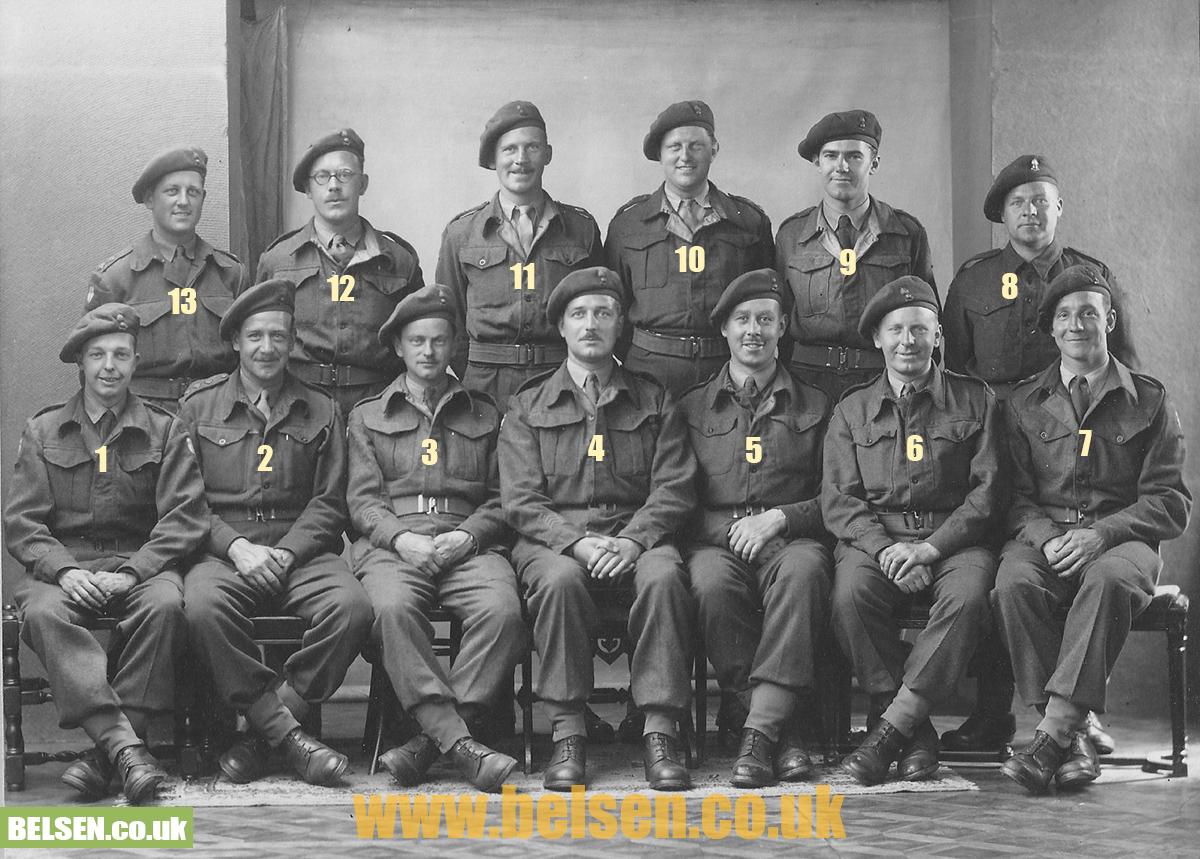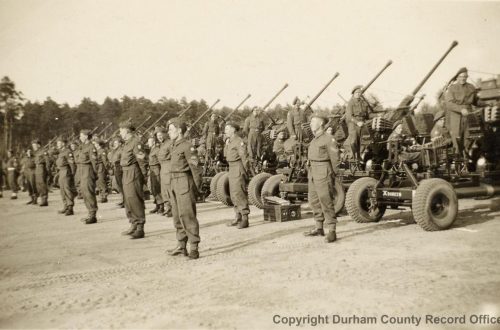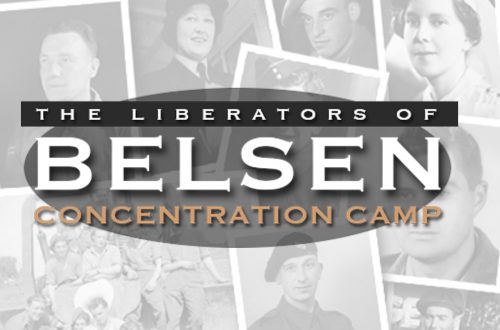John Crosbie (Jack) Lt. 113th LAA DLI
This article was written by John J. Crosbie (known as Jack) in March 1964. Jack was born in Girvan in 1915 and after the war he lived in Giffnock with his wife and two sons until his death in 1995.
 During the war, Jack was a Lieutenant in the Royal Artillery* and was haunted by his experience of helping to liberate Belsen Concentration Camp in March 1945. It took him 19 years to be able to express some of his pain in committing his thoughts to paper. The pain of these memories remained with him every day until his death until 1995. His experiences are a testimony to future generations.
During the war, Jack was a Lieutenant in the Royal Artillery* and was haunted by his experience of helping to liberate Belsen Concentration Camp in March 1945. It took him 19 years to be able to express some of his pain in committing his thoughts to paper. The pain of these memories remained with him every day until his death until 1995. His experiences are a testimony to future generations.
(*Assuming here 113th DLI LAA RA, with references and pointers within the text – ED)
UPDATE: Confirmed 113th – ED
I suppose that the memory of Belsen Concentration Camp is something that will be with me until the end of my days. It was one of these experiences in life which hit so hard that the scar will forever remain. And yet, come to think of it, nineteen years have gone by since I turned the nose of the Jeep into the Camp Entrance and drove into a scene of such horror and confusion that battle-scarred veterans were sick on the spot and men stood, weeping openly, unable to believe the sight before their eyes. In Western Germany today the public are divided in their attitude toward the trials of those who committed atrocities against the Jews during Hitler’s Rule. The younger ones feel that it happened such a long time ago and it ought to be forgotten…..older Germans rightly aver that those who responsible should be brought to Justice.

(Jack is here as number 7)
In March 1945 we had been among the first to cross the Rhine at Wesel and then we seemed to sit and watch the rest of the British Second Army leapfrog over us deep into the heart of Germany. The advance was swift and as each day passed a fresh list of towns was added to the lengthening number of Allied victories. Our Commanding Officer, a burly Yorkshireman, was not at all happy with the situation, and hurried each morning to Brigade Headquarters demanding another commitment for the Regiment. He was determined that we should not be left behind and he was not to be disappointed. On 12th April 1945, the German Military Commander at Bergen-Belsen, who was Chief of Staff 1st Para Army, approached the Commander of the British 8th Corps and negotiated a truce to avoid serious fighting in the area of Belsen Concentration Camp, which was at the time some 12 miles behind the German front line. The camp was in a state of chaos. Between 45,000 and 50,000 Jewish internees were imprisoned there, a great many of them suffering from Typhus, Typhoid, Gastro-enteritis, or Tuberculosis. They were without food and the electricity and water supply had failed. Such then was the position when, after covering 250 miles in under 24 hours the main column entered that dreadful place on 18th April 1945.
The scene which confronted us on that day can never be forgotten. Some 10,000 bodies, nearly all of them naked and many in an advanced state of decomposition, lay on the ground between the huts, forming an almost continuous carpet. The FILTH of human excreta and decomposing flesh was everywhere.
The stench was indescribable. Living conditions were by any standards absolutely disgraceful. There were no sanitary arrangements of any kind and huts, which normally accommodated 60, were housing as many as 500/600. Those poor miserable internees had long since lost all self-respect and any sense of moral code and were living like animals. Clothing was torn from a body as soon as the struggle to stay alive had ended. It was not uncommon for someone to shamble up to you and in the middle of speaking drop dead at your feet. Those who were fit enough searched the camp area continuously looking for herbs and traces of food which they heated in a can over a fire made from a few twigs. Hundreds of these fires could be seen all over camp, each with a wisp of smoke towering up to the sky and each with a group of inmates, crouching around it in a hopeless endeavour to keep warm. These people had gone without food for 7 days…before that they has been existing on a starvation diet of some soup and a few grams of black bread. It was little wonder that most of them required hospital treatment. This then was Belsen….it was a one-way ticket to death through starvation.
The task ahead of the British Forces was formidable. The dead had to be buried (and they were dying at the rate of 400/500 per day), those who were in need of hospital treatment had to be evacuated quickly from the area, food and water had to be organised and a Bengal diet distributed to the famished thousands whose lives depended on quick action. Each of the 5 cookhouses was equipped with a number of large boilers, the only containers available for the distribution of food being a few large dustbins.
Belsen was officially known as the Krankenlager…… that is a sick camp. The unfortunate human beings who were sent there in train loads never came back. They faced a death through disease, starvation and sheer physical degradation. There was no gas chamber, but many internees were subjected to sterilisation and medical experiment. Prisoners were beaten and flogged at the slightest provocation. Roll-call each day was at 08:00 hours and those who were sick or dying had to be carried out to the parade ground by their friends. The daily diet consisted of 3 pints of Swede soup and 250 grams of black bread. During the months preceding liberation, there were many cases of cannibalism and these were vouched for by many witnesses. None of the British soldiers who were there will ever forget the pile of boots and shoes which stood not far from the entrance to the camp. It was 12 feet high, 40 feet long and 20 feet broad, and it must have contained thousands upon thousands of pairs of shoes. It stood there as a memorial to the many thousands who had gone before.
The task of burying the dead was given to the S.S Prison Guards. Under the supervision of the Royal Artillery they loaded the corpses on to large German trailers which were towed by gun tractors to the death pits to await mass burial. These S.S Guards were the toughest thugs one could meet. They had ruled with the aid of the whip and the gun, and now that the tables were turned (for they had been ‘sold out’ to the British by the Wehrmacht), they knew full well the fate that awaited them. Yet never once, even although we worked them until they dropped, did I see one shed a tear or show one single sign of emotion. Had they not been guarded day and night they would have been torn limb from limb by the internees. That is all except one – an S.S doctor who walked through the camp in uniform receiving from each of the inmates a bow or curtsy of respect.
I remember well some of the special regulations that had to be applied to meet situation. It was forbidden to blow the horn of a vehicle, otherwise some unfortunates would drop dead through fright. A soldier dare not throw away an empty can lest some starving internees should fight to the death over the last few drops of bean juice which remained at the foot of it. Ration trucks and water carts had to be guarded by a soldier with a rifle sitting on top, otherwise they would not have reached their destination.
Each Royal Artillery Officer was put in charge of a cookhouse and one day I was approached by one of the internees who volunteered to supervise the issue of rations from the cookhouse store and so (to use his own words) “take some of the weight off my shoulders”. He was one of the fitter specimens and had only been in the camp for two or three weeks. I asked him about his qualifications and how he came to speak such perfect English. Quite modestly he told me that he had been Professor of Mathematics at Vienna University before being picked up by the S.S. His wife and children had been judged unfit to work and had gone to the gas chambers at infamous Auschwitz. After he had worked for a few months in a factory he too fell ill, and was then sent to Belsen.
I remember how the Camp Commandant, who was reputed to have in his house a lampshade made of human skin, was locked up for safe keeping in the large refrigerator of a nearby Tank training school. Along came the Royal Engineers to repair the electrical supply and by the time anyone had remembered about the Camp Commandant he was very cold indeed. However, he still lived to face the executioner a few months later. We welcomed the arrival of the 100 students from the London Hospitals whose job it was to see that the very sick got something to eat……….what a wonderful job they did. We ordered the Burgomeisters of the nearby villages to come and see the horrors with their own eyes. They wept, protesting that they were ignorant of what had gone on behind the barbed wire of Belsen. I think they were quite truthful, for anyone who ever escaped never dared to mention the fact even to his closest friend, otherwise he was back in captivity again in a very short time. The Concentration Camp number tattooed on his wrist could never be removed. The S.S women were also made to take their share of burial duties. They were so tough that they spat in our faces without the slightest provocation. I remember the attractive face of Irma Grese …….a face which gave little indication of the vile character which lay beneath. She, too, was later convicted of atrocities against the Jews and had to face the executioner.
In the next six weeks, the Military Government arranged the disinfestation of all prisoners through a human laundry system and then evacuated every sick person from the Concentration Camp Area. Many thousands, after being re-clothed and re-equipped were repatriated to their own countries. Eventually, the Royal Artillery burned down the last hut, and only the mass graves remained to mark the area in among those beautiful pine trees where death had been so commonplace. I shall always remember the sign which we erected on the main road at the entrance to the camp. It said….. “This is the site of the infamous Belsen Concentration Camp, liberated by the British on 15th April 1945. 10,000 unburied dead were found here…another 13,000 have since died…all of them victims of the German New Order in Europe, and an example of Nazi Kultur”.
……………………………………………………………………………………………………
March 1964
14,719 total views


